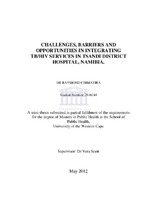| dc.contributor.advisor | Scott, Vera | |
| dc.contributor.author | Chimatira, Raymond | |
| dc.date.accessioned | 2014-06-11T07:08:08Z | |
| dc.date.available | 2014-06-11T07:08:08Z | |
| dc.date.issued | 2012 | |
| dc.identifier.uri | http://hdl.handle.net/11394/3308 | |
| dc.description | Magister Public Health - MPH | en_US |
| dc.description.abstract | BACKGROUND: Namibia has generalised Human Immunodeficiency Virus (HIV) and tuberculosis (TB) epidemics. In response to the TB/HIV co-epidemics in Namibia, the Ministry of Health and Social Services approved a policy of TB/HIV collaborative activities at national level and the integration of TB/HIV services at the point of service delivery. The present study explored barriers and facilitators of integration of TB and HIV service delivery in Tsandi District Hospital, which lies in rural northern Namibia. It focused on understanding the perspectives of healthcare workers and service users on integration of TB and HIV services at the health facility. AIMS & OBJECTIVES: The study aimed to describe the barriers, facilitators, and opportunities of integrated TB/HIV service delivery in Tsandi District Hospital. The specific objectives were: to describe the staffing and support systems in place for the integration of TB/HIV care; to describe the perceptions and experiences of integrated TB/HIV care by the health care workers, management and co-infected clients; and to describe the factors that facilitate or hinder the integration of TB/HIV services in the district from the point of view of district hospital managers, health care workers and co-infected clients. METHODS: The study used a descriptive qualitative study design with semistructured key-informant interviews conducted with five healthcare managers and senior clinicians and focus group discussions with 14 healthcare workers and five TB/HIV co-infected patients, supplemented by non-participant observation in Tsandi district hospital over two weeks between May – June 2011. Sessions were audiorecorded, transcribed, and thematically analysed. RESULTS: Several factors influenced whether and to what degree Tsandi district hospital was able to achieve integration of TB and HIV services. These are: (1) model of care and nature of referral links; (2) the availability and use of human resources and workspace; (3) the system of rotating staff among departments in the hospital; (4) the supply and mode of providing medicines to patients; (5) information systems, recording and reporting arrangements; (6) and the amount of follow-up and
supervision of the integrated services. The main suggested barrier factors are: (1) poor
communication and weak referrals links between services; (2) inadequate infrastructure to encourage and deliver TB and HIV care; (3) staff shortages and high workload; (4) lack of training and skills among healthcare workers; (5) financial constraints and other socioeconomic challenges; and (6) fragmented recording and reporting systems with limited data use to improve service delivery. The four main facilitating factors are: (1) positive staff attitudes towards TB/HIV integration; (2) common pool of staff managing different programmes; (3) joint planning and review of TB and HIV activities at the ARV Committee; and (4) informal task sharing to alleviate healthcare worker shortages.
CONCLUSIONS: This study recommends that the district build on the current facilitators of integration, while the inhibitors should be worked on in order to improve the delivery of TB/HIV services in the district. Simple and practical recommendations have been made to address the some of the barriers at district level. It is hoped that these will inform future planning and review of the current model of care by the District nagement Team. | en_US |
| dc.language.iso | en | en_US |
| dc.publisher | University of Western Cape | en_US |
| dc.subject | Tuberculosis | en_US |
| dc.subject | Human immunodeficiency virus | en_US |
| dc.subject | TB/HIV co-infection | en_US |
| dc.subject | TB/HIV collaboration | en_US |
| dc.subject | Health policy implementation | en_US |
| dc.subject | Integrated TB/HIV service delivery | en_US |
| dc.subject | District health system | en_US |
| dc.subject | Namibia | en_US |
| dc.subject | Tsandi | en_US |
| dc.subject | Rural | en_US |
| dc.title | Challenges, barriers and opportunities in integrating TB/HIV services in Tsandi District Hospital, Namibia | en_US |
| dc.type | Thesis | en_US |
| dc.rights.holder | University of Western Cape | en_US |

